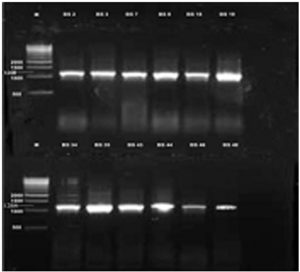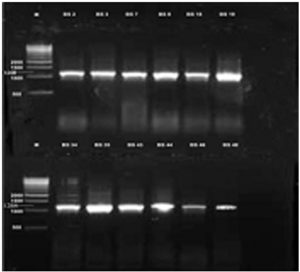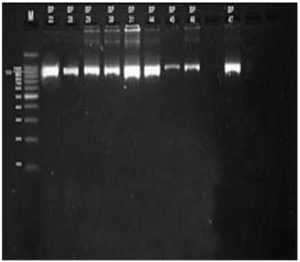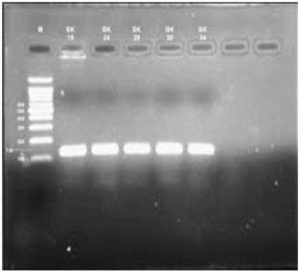ISSN: 0973-7510
E-ISSN: 2581-690X
Bovine mastitis is an important disease of cattle which affects economy of the country. The purpose of study was isolation and identification of the common bacterial causes of clinical bovine mastitis. To this end, 50 bovine milk samples from CMT confirmed-clinical mastitis cases were collected and cultured on Nutrient agar, Blood agar and Mac-Conkey agar plates for bacterial isolation. The major pathogens isolated were Escherichia coli (28%), Staphylococcus aureus (24%), Pseudomonas aeruginosa (18%), Klebsiella pneumoniae (10%) and Streptococcus sp. (2%) as per the biochemical tests and PCR. In conclusion, high percentage of positive samples and relatively high occurrence of environmental microorganisms indicates urgent need to emphisize udder hygiene for clean milk production.
Bovine Mastitis, PCR, Staphylococcus, E. coli, Pseudomonas
Mastitis is one of the most important diseases in dairy animals resulting into huge economic losses to the country. The losses due to mastitis are temporary or permanent loss of milk production, poor milk quality, discarding of milk from affected animals prior to or after antibiotic treatment and pre-mature culling of the cow or reduced productive life of animals. Mastitis is defined as an inflammation of the parenchyma of mammary gland, which not only reduces milk yield but alters milk composition (Souto et al., 2010) also. The microbial species that commonly cause bovine mastitis, such as Escherichia coli, Klebsiella pneumoniae, Streptococcus agalactiae and Staphylococcus aureus also occur as commensals or pathogens of humans. Whereas other causative species, such as Streptococcus uberis, Streptococcus agalactiae are almost exclusively found in animals (Zadoks et al., 2011).
Compared to culture, the PCR assays are less time consuming takes less than 24 hours to complete, while identification of bacteria to the species levels by conventional microbiological and biochemical methods requires more than 72 hours. Thus a PCR based method act as a useful tool for confirmatory diagnosis of pathogens of mastitis.
Clinical samples
A total of 50 mastitic milk samples were collected from different locations in and around the Bikaner city, Rajasthan. The bacteria were isolated in pure culture on Nutrient Agar. Further identification of bacteria was done on the basis of colony characters; Gram’s staining reaction, growth patterns on Blood Agar and Mac Conkey Agar (i.e., hemolysis and lactose fermentation, respectively) followed by motility, morphology, and biochemical tests (Indol , MR, VP, Citrate and Catalase).
Genotypic characterization
Although, phenotypic identification of bacterial cultures using biochemical tests is one of the standard methods for identification of any bacteria, variability in biochemical tests at times lead to misidentification of these organisma, therefore genotypic tests such as PCR was attempted for the confirmation.
23S rRNA based genotyping of E. coli
In the present investigation all E. coli isolates were subjected to PCR amplification targeting 23S rRNA gene using species specific primers. All isolates yielded species specific amplicon of 232bp by using primers reported by Riffon et al. (2001).
 Agarose Gel electrophoresis of PCR amplified 23SrRNA gene (232 bp) of E. coli isolates. M: 100 bp DNA ladder
Agarose Gel electrophoresis of PCR amplified 23SrRNA gene (232 bp) of E. coli isolates. M: 100 bp DNA ladder
23S rRNA based genotyping of S. aureus
In the present investigation all isolates of S. aureus were subjected to PCR amplification targeting 23S rRNA using species-specific primers reported by Riffon et al. (2001).

Agarose Gel electrophoresis of PCR amplified 23SrRNA gene (1268 bp) of S. aureus isolates. M: 1000 bp DNA ladder
16S rRNA based genotyping of P. aeruginosa
In the present study, all 9 isolates, which had been biochemically identified as P. aeruginosa, were subjected for genotyping by using species-specific primers as reported in earlier studies (Spilker et al., 2004).

Agarose Gel electrophoresis of PCR amplified 16SrRNA gene (956 bp) of P. aeruginosa isolates. M: 100 bp DNA ladder
16-23S rDNA inter transcribed spacer (ITS) region based genotyping of K. pneumoniae
In the present investigation, all 5 K. pneumoniae isolates were subjected to PCR amplification targeting 16S–23S rDNA internal transcribed spacer (ITS) region based specific primers (Liu et al., 2008) .

Agarose Gel electrophoresis of PCR amplified 16S23S rDNA inter transcribed spacer (ITS) region (110 bp) of K. pneumoniae isolates. M: 100 bp DNA ladder
23S rRNA based genotyping of Streptococcus agalactiae
Streptococcus spp. isolates were subjected to PCR amplification targeting 23S rRNA spacer region by using S. agalactiae, S. dysgalactiae and S. uberis species-specific primers with 587 bp, 403 bp and 95 bp 23S rRNA spacer region based studies were conducted by Riffon et al. (2001) for genotypic confirmation of Streptococcus agalactiae isolated from bovine mastitic milk and they observed 587 bp PCR product.
In the present study, mastitic causing pathogens were isolated from 66% cases, while no growth was evident in 34%. The failure of pathogens to grow in-vitro in high percentage of samples may be because of premedication of the animals with antibiotics, non-bacterial causes and the type of media that did not support the growth of whole range of bacteria associated with mastitis.
All 14 isolates of E. coli on preliminary biochemical characterization revealed characteristic IMViC pattern, growth on TSI (Y/Y/-) and fermented different sugars. Preliminary biochemical characterization of all 12 isolates of S. aureus revealed characteristic growth pattern on mannitol salt agar, showed haemolysis on blood agar, DNAse test and fermented different sugars. All 9 P. aeruginosa isolates revealed standard biochemical characterization as growth at 42oC, pigment production, growth on triple sugar iron (TSI) agar (R/R/-), citrate utilization, arginine hydrolysis, gelatin liquefaction, haemolysis and nitrate reduction. Negative reaction was observed for aesculin hydrolysis and urease tests. All 5 isolates of K. pneumoniae on preliminary biochemical characterization revealed characteristic IMViC pattern, growth on TSI (Y/Y/-) and fermented different sugars. One Streptococcus agalactiae isolate showed dew drop like colonies on Edward’s medium, 6.5% sodium chloride medium, hydrolysed aesculin, and fermented different sugars.
A total of 41 bacterial isolates could be cultured and identified by biochemical and genotypic test, which consisted of 14 (28%) isolates of E. coli, 12 (24%) isolates of S. aureus, 9 (18%) isolates of P. aeruginosa, 5 (10%) isolates of K. pneumoniae and 1(2%) isolate of Streptococcus agalactiae.
Bovine mastitis is an important disease that afflicts dairy industry through decrease in milk quality and quantity. Various species of bacteria such as E. coli, S. aureus, S. agalacticae, P. aeruginosa and K. pneumoniae are involved in causing mastitis and affecting milk production consequently. In the present investigation, all E. coli isolates were subjected to PCR amplification targeting 23S rRNA gene using species-specific primers and amplicon size matched with those reported by Riffon et al. (2001). Prevalence of E. coli in mastitis cases generally suggests poor udder hygiene and the results obtained in this study are in agreement with those obtained by ,Bradely et al., 2002, Khaled et al., 2010., Sayed, 2014, who have also reported higher incidence of E.coli. The biochemical characterization of isolates and fermentation of sugars are comparable with studies of Kruthi (2006) and Pachaury (2011).
All 12 isolates of S. aureus complied with standard biochemical and sugar fermentation tests, and results obtained were in concurrence with that of Upadhyay (2009), who carried out fermentation studies with S. aureus obtained from milk of mastitic cattle and goat. There have been reports of amplification of other genomic fragments viz.,23S rRNA for genotypic confirmation of S. aureus strains isolated from bovine mastitis (Straub et al.,1999; Stephan et al., 2001; Salasia et al., 2004; Sanjiv et al., 2008; Bhanderi et al., 2009; Momtaz et al., 2010 and Upadhyay et al., 2010), that generated species specific amplicon of 1250 bp. Khaled et al. (2010) have also used 23S rRNA gene based system, albeit generated species-specific amplicon of 1318 bp using a different set of primers.
Streptococcus spp. isolates were biochemically confirmed and subjected to PCR amplification, targeting 23S rRNA spacer region, by using S. agalactiae, S. dysgalactiae and S. uberis species-specific primers that generated 587 bp, 403 bp and 95 bp amplicons. 23S rRNA spacer region based studies were conducted by Riffon et al. (2001) for genotypic confirmation of Streptococcus agalactiae organisms isolated from bovine mastitic milk and they observed 587 bp PCR product. 16S-23S rRNA spacer region based studies were conducted by Forsman et al. (1997) for genotypic confirmation of Streptococcus spp. isolated from bovine mastitic milk and they observed 280 bp, 270 bp, and 330 bp PCR product for S. agalactiae, S. dysgalactiae and S. uberis respectively. Phuektes et al. (2001) also used 16S-23S rRNA spacer region for differentiating S. agalactiae, S. dysgalactiae and S. uberis based on amplicon size. There have been reports (Khaled et al., 2010), where amplification of other genomic sites viz., 16S rRNA gene for differentiating S. agalactiae (405 bp) and S. dysgalactiae (281 bp) by amplicon size. 16S rRNA, 23S rRNA and 16S-23S rRNA spacer region based PCR have been developed by Hassan et al. (2001) for S. uberis and they observed 445 bp, 451 bp, and 330 bp respectively for 16S rRNA , 23S rRNA and 16S-23S rRNA spacer region.
In the present study, all 8 isolates which had been biochemically identified as P. aeruginosa were subjected to genotyping using species-specific primers reported earlier (Spilker et al., 2004). All 8 isolates subjected to PCR using species specific primers produced the product of 956 bp as reported by Spilker et al. (2004). All the isolates could be amplified using the said PCR indicates higher sensitivity and specificity of this test.
In the present investigation, all 5 isolates, which had been biochemically identified as K. pneumoniae were subjected to PCR amplification targeting 16S–23S rDNA internal transcribed spacer (ITS) region based specific primers (Liu et al., 2008) and our results are completely in agreement with that of Liu et al., 2008.
In conclusion, high percentage of positive samples and relatively high occurrence of environmental microorganisms indicates urgent need to emphisize udder hygiene.
- Bhanderi, B.B., Roy, A., Yadav M.M., Joshi C.G. PCR based detection of virulence based genes of Staphylococcus aureus from bovine clinical and subclinical mastitis. Journal Royal Veterinary Journal of India. 2009; 5 (I & II) : 20-26.
- Bradley A.J. Bovine mastitis : an evolving diseases. The Veterinary journal. 2002; 163 : 1-13.
- Forsman, P.; Tilsalatimisjarvi, A. and Alatossava, T. Identification of staphylococcal and streptococcal causes of bovine mastitis using 16S-23S rRNA spacer regions. Microbiology. 1997; 143 : 3491-3500.
- Hassan, A. A.; Khan, I. U.; Abdulmawjood, A. et al., Evaluation of PCR methods for rapid identification and differentiation of Streptococcus uberis and Streptococcus parauberis. Journal of Clinical Microbiology. 2001; 39 (4) : 1618-1621.
- Khaled, A. Abd El-Razik., Khaled, A.Abdelrahman., Yousse, F. Ahmed., Alaa, M. Gomaa. Hazem, A. Eldebaky. Direct Identification of Major Pathogens of the Bubaline Subclinical Mastitis in Egypt using PCR. Journal of American Sciences. 2010; 6(10).
- Kruthi, M. Phenotypic characterization of E.coli strainsisolated from human intestinal and urinary tracts. Thesis submitted for M.Sc. Biotechnology, Wright state university 2006.
- Liu, Y., Liu C., Zheng ,W., Zhang X., Yu ,J., Gao, Q., Hou, Y., Huang, X. PCR detection of Klebsiella pneumoniae in infant formula based on 16S–23S internal transcribed spacer. International Journal of Food Microbiology. 2008; 125: 230-235
- Momtaz, H., Rahimi, E., Tajbakhsh, E. Detection of some virulence factors in Staphylococcus aureus isolated from clinical and subclinical bovine mastitis in Iran. African Journal of Biotechnology. 2010; 9(25) : 3753-3758.
- Pachaury, R. Genotypic and phenotypic characterization of Escherichia coli isolated from diarrhoeic calves, lambs and kids. M.V.Sc. Thesis submitted to RAJUVAS, Bikaner, Rajasthan 2011.
- Phuektes, P., Mansell, P.D., Browning, G. Multiplex Polymerase Chain Reaction Assay for Simultaneous Detection of Staphylococcus aureus and Streptococcal Causes of Bovine Mastitis Journal of Dairy Sciences. 2001; 84: 1140–1148.
- Riffon,R., Sayasith,K., Khalil,H., Dubreuil,P., Drolet,M., Lagacé J. Development of a Rapid and Sensitive Test for Identification of Major Pathogens in Bovine Mastitis by PCR. Journal of Clinical Microbiology. 2001; 39(7): 2584.
- Salasia, S. I., Khusnan, Z., Lamme, R C. and Zschock, M. Comparative studies on phenotypic and genotypic properties of Staphylococcus aureus isolated from bovine sub-clinical mastitis in central Java in Indonesia and Hesse in Germany. Journal of Veterinary Sciences. 2004; 5(2) : 103-109.
- Sanjiv, K., Kataria, A. K., Sharma, R.and Singh, G. Epidemiological typing of Staphylococcus aureus by DNA restriction fragment length polymorphism of coa gene. Veterinarski Arhiv 2008; 78 (1) : 31 -38.
- Sayed, S.M. A contribution on Coliforms causing mastitis in cows with reference to serotypes and virulence factors of E. coli isolates. Assiut University Bulletin for Environmental Researches. 2014; 17.
- Spilker, T., Coenye, T., Vandamme, P., LiPuma, JJ. PCR-Based Assay for Differentiation of P.aeruginosa from other Pseudomonas Species Recovered from Cystic Fibrosis Patients. Journal of Clinical Microbiology. 2004; 42(5) : 2074-2079.
- Stephan, R., Annemu Èller C., Hassan AA., La Èmmler. Characterization of enterotoxigenic Staphylococcus aureus strains isolated from bovine mastitis in north-east Switzerland. Veterinary Microbiology. 2001; 78 : 373-382.
- Straub, J.A., Hertel,C., Hammes, W.P. A 23S rRNA target polymerase chain reaction based system for detection of Staphylococcus aureus in meat starter cultures and dairy products. Journal of Food Production. 1999; 62(10) : 1150-1156.
- Upadhyay, A.and Kataria,A.K. Haemolytic properties and titration of haemolysins of Staphylococcus aureus of milk origin from cattle and goat with clinical mastitis. Indian Journal of Veterinary Research. 2010; 19(2): 60-65.
© The Author(s) 2017. Open Access. This article is distributed under the terms of the Creative Commons Attribution 4.0 International License which permits unrestricted use, sharing, distribution, and reproduction in any medium, provided you give appropriate credit to the original author(s) and the source, provide a link to the Creative Commons license, and indicate if changes were made.


